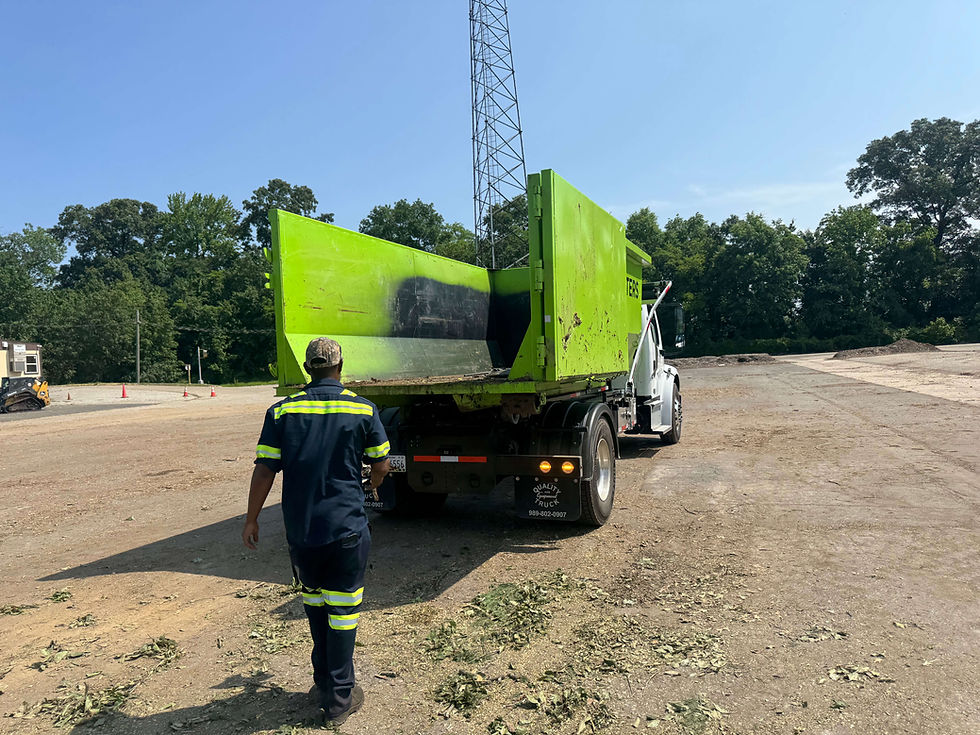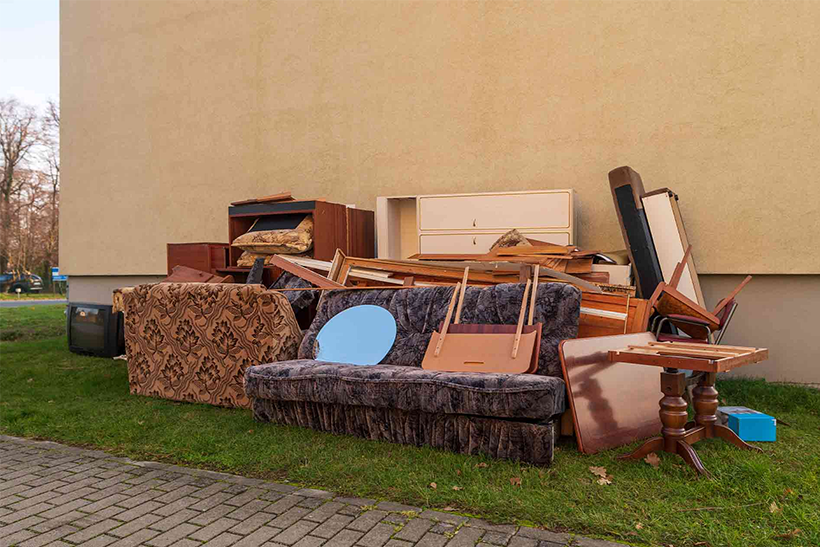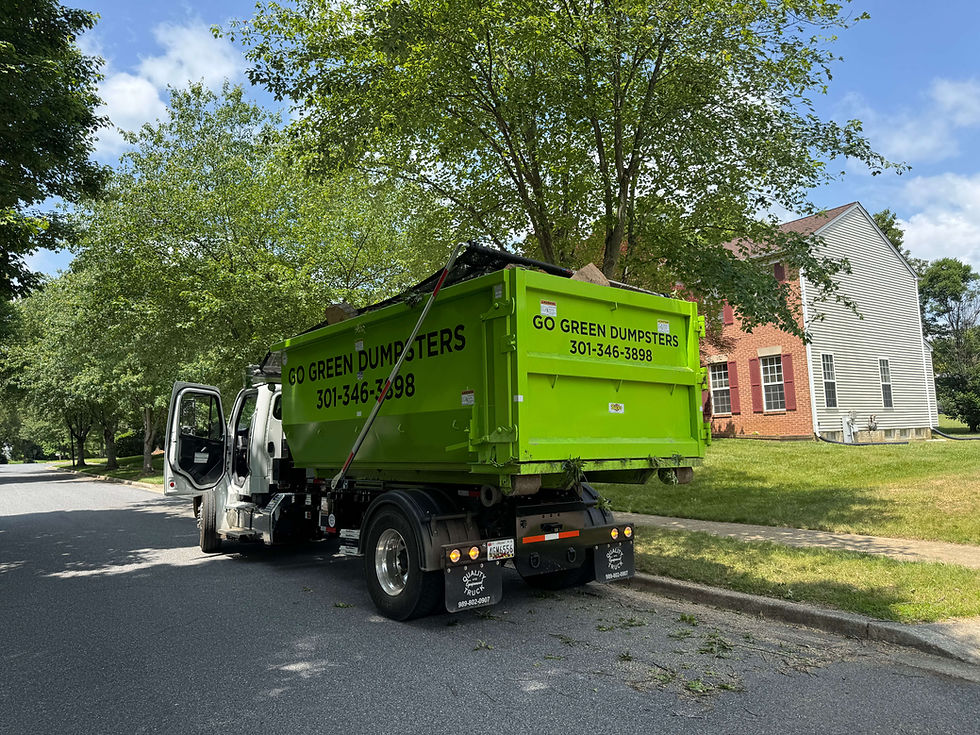Maximize Your Dumpster Space: Packing Tips to Save Money
- Paulo Miller
.png/v1/fill/w_320,h_320/file.jpg)
- Sep 24
- 5 min read
Packing a dumpster efficiently saves time, money, and hassle on any remodel or cleanup. Small changes in how you break down and load materials can stretch your rental’s capacity and reduce the risk of overweight fees. This guide offers practical steps contractors and homeowners in Maryland and DC can use to fit more into each drop and avoid a costly second pickup. Contact and confirm the right size with us before your deliver.
Plan your load before delivery

Estimate volume and weight needs
Start by making a short inventory of what you will toss: cabinetry, drywall, roofing, cardboard, and heavy masonry all behave differently in a dumpster. Estimate both volume and likely weight so you can tell your hauler what to expect and avoid surprises at the transfer station. In Maryland and DC, local tipping fees and weight allowances change from county to county, so a quick material list helps your provider recommend the best flat-rate option. If you want to be sure which option fits your budget, check out our pricing page for a clear breakdown of what's included.
Stage materials for faster loading
Keep like materials grouped in the work area—drywall with drywall, lumber with lumber, cardboard with cardboard. Staging speeds up the loading crew and prevents inefficient filling that wastes space. If you’re working across multiple houses or a scattered site in Prince George’s or Montgomery County, label piles so drivers can spot what to load first.
Break down bulky items

Disassemble cabinetry and furniture
Cabinets, doors, and large furniture take up a lot of airspace if tossed whole. Remove doors, shelves and hardware and stack flat pieces to create compact bundles. Breaking these large items down reduces voids and lets you pack other debris around and over them.
Cut countertops, drywall and trim into panels
Use a saw to section countertops and large trim into manageable pieces and stack them upright along the dumpster length. Drywall sheets are easier to load and compact when cut into halves or thirds and placed on edge; this also minimizes breakage and sharp waste inside the bin.
Load strategically for space and balance
Heavy items first, light materials on top
Place the densest materials — bricks, concrete chunks, tile — at the bottom so they don’t crush lighter materials and to keep the load stable. Once heavy items are bedded, fill gaps with insulation, cardboard, or loose packaging. This method helps you use volume efficiently while maintaining a safer, well-balanced container for transport.
Fill gaps and nest materials
Look for cavities between bulky pieces and stuff them with broken-down boxes, trim, or strip wood. Nesting curved or oddly shaped items together reduces wasted space and prevents shifting during hauling. A well-packed load often fits two to three extra pickup-truck loads worth of material compared with a loosely tossed bin.
Handle heavy materials smartly

Know when weight (not volume) controls the job
Concrete, pavers, and compacted soil reach weight limits far before you run out of room. For jobs that include masonry or tile, plan to purchase additional tonnage or choose a heavy-material rated container to avoid overweight fees. Tell the hauler about the proportion of stone or concrete when booking your rental.
Break and separate dense materials
When possible, break concrete and asphalt into smaller pieces and mix them with lighter debris to spread the weight. Avoid stacking all dense materials in a single pocket; distribute heavier pieces evenly across the base of the dumpster to prevent concentrated loads that trigger overweight surcharges.
Avoid prohibited items and protect your cost
Keep regulated materials out of the load
Tires, batteries, appliances with refrigerant, asbestos, and hazardous liquids must not be placed in a standard dumpster. Mixing prohibited items into your load can cause full truck rejection and steep penalties. Use county Household Hazardous Waste options in Anne Arundel or check local DC rules for appliance disposal to stay compliant and avoid surprise bills.
Label and separate questionable items on site
If you suspect something might be restricted, set it aside in marked containers instead of tossing it in the bin. This protects your whole load from being rejected and helps haulers estimate true weight and disposal needs when they arrive.
Tools, supplies and small hacks that add capacity

Bring the right tools and packing supplies
Have a reciprocating saw, pry bar, utility knife, and heavy-duty gloves on hand to break down items quickly. Keep a stack of plywood sheets or old doors to form temporary ramps and use moving straps or tarps to compress light debris. These small investments speed loading and help you compact more material into each rental.
Compress soft materials and recycle what you can
Squeeze or compress foam, insulation, and loose packing before loading, and bundle cardboard tightly. Recyclable materials like metal, clean wood, and cardboard often have separate streams; diverting them to the right recycler lowers landfill volume and can trim your disposal bill in Maryland’s competitive markets.
Final check and safety
Inspect the load before pickup
Walk the perimeter of the dumpster and make sure nothing protrudes above the rim that could break during transport, and confirm hazardous items are segregated. Take photos of the loaded container for your records; images can be useful if a transfer-station dispute or overweight charge arises.
Communicate with your hauler and confirm pickup windows
Confirm pickup times and any access details with the hauler the day before. Clear communication about obstructions, permits, or narrow driveways prevents failed delivery attempts and keeps your project timeline intact across Prince George’s, Montgomery, Anne Arundel, and DC service areas.
Efficiently packing a dumpster saves money and reduces stress on any Maryland or DC project. Start by staging and breaking down bulky items, load heavy pieces first and fill gaps with lighter material, and be mindful of weight limits so dense materials don’t force costly overage fees. Keep prohibited items separate and use local HHW or appliance-recycling options for regulated waste. Finalize the job with a quick inspection, photos, and a call to your hauler to confirm pickup. These steps help you get the most from a single rental and keep your site safer and cleaner.
Frequently Asked Question
How can I tell if my materials will hit the weight limit?
Estimate the mix of heavy and light debris in your load and list the major dense items, like concrete, brick and tile in your booking details. Your hauler can advise on likely weight based on those materials and may recommend extra tonnage or a heavy-material container for projects in Maryland and DC.
Is it worth breaking down cabinets and countertops?
Yes. Disassembling cabinetry and cutting countertops into sections reduces wasted airspace and lets you stack flat panels efficiently. The time spent breaking items down usually pays off by avoiding a second dumpster or overweight charges.
What are simple tricks to compress bulky soft materials?
Use straps or strong rope to bind insulation and foam into compact bundles, and flatten cardboard before tying it into bales. These small steps make a noticeable difference in how much volume you can store in the bin.
Can I mix heavy masonry with light trash in the same dumpster?
You can mix materials, but be strategic: place heavy masonry across the base and distribute it evenly to avoid concentrated weight. If masonry makes up a large portion of the load, plan for additional tonnage even if the bin still has visible space.
What if I accidentally put a prohibited item in the dumpster?
Stop loading and separate the item into a marked container. Contact your dumpster provider immediately. Prompt action may prevent the whole truck from being rejected and reduce extra charges; for regulated wastes, use county HHW programs or licensed haulers.
How much more can I fit by packing efficiently?
A well-packed dumpster can often hold the equivalent of one to three extra pickup-truck loads compared with a poorly packed one. Results vary by material mix, but the combination of disassembly, nesting, and gap-filling regularly delivers measurable savings.



Comments